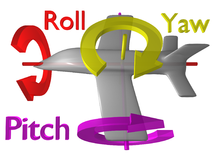
Back Vaste liggaam Afrikaans جسم جاسئ Arabic Абсалютна цвёрдае цела Byelorussian Абсалютна цьвёрдае цела BE-X-OLD Абсолютно твърдо тяло Bulgarian Sòlid rígid Catalan Tuhé těleso Czech Абсолютлă хытă ĕскер CV Starrer Körper German Μηχανικό σώμα Greek

| Part of a series on |
| Classical mechanics |
|---|
In physics, a rigid body, also known as a rigid object,[2] is a solid body in which deformation is zero or negligible. The distance between any two given points on a rigid body remains constant in time regardless of external forces or moments exerted on it. A rigid body is usually considered as a continuous distribution of mass.
In the study of special relativity, a perfectly rigid body does not exist; and objects can only be assumed to be rigid if they are not moving near the speed of light. In quantum mechanics, a rigid body is usually thought of as a collection of point masses. For instance, molecules (consisting of the point masses: electrons and nuclei) are often seen as rigid bodies (see classification of molecules as rigid rotors).
- ^ Lorenzo Sciavicco, Bruno Siciliano (2000). "§2.4.2 Roll-pitch-yaw angles". Modelling and control of robot manipulators (2nd ed.). Springer. p. 32. ISBN 1-85233-221-2.
- ^ Andy Ruina and Rudra Pratap (2015). Introduction to Statics and Dynamics. Oxford University Press. (link: [1])
